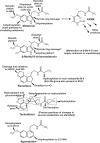New approaches in the management of insomnia: weighing the advantages of prolonged-release melatonin and synthetic melatoninergic agonists
- PMID: 19557144
- PMCID: PMC2699659
- DOI: 10.2147/ndt.s4234
New approaches in the management of insomnia: weighing the advantages of prolonged-release melatonin and synthetic melatoninergic agonists
Abstract
Hypnotic effects of melatonin and melatoninergic drugs are mediated via MT(1) and MT(2) receptors, especially those in the circadian pacemaker, the suprachiasmatic nucleus, which acts on the hypothalamic sleep switch. Therefore, they differ fundamentally from GABAergic hypnotics. Melatoninergic agonists primarily favor sleep initiation and reset the circadian clock to phases allowing persistent sleep, as required in circadian rhythm sleep disorders. A major obstacle for the use of melatonin to support sleep maintenance in primary insomnia results from its short half-life in the circulation. Solutions to this problem have been sought by developing prolonged-release formulations of the natural hormone, or melatoninergic drugs of longer half-life, such as ramelteon, tasimelteon and agomelatine. With all these drugs, improvements of sleep are statistically demonstrable, but remain limited, especially in primary chronic insomnia, so that GABAergic drugs may be indicated. Melatoninergic agonists do not cause next-day hangover and withdrawal effects, or dependence. They do not induce behavioral changes, as sometimes observed with z-drugs. Despite otherwise good tolerability, the use of melatoninergic drugs in children, adolescents, and during pregnancy has been a matter of concern, and should be avoided in autoimmune diseases and Parkinsonism. Problems and limits of melatoninergic hypnotics are compared.
Keywords: agomelatine; hypnotics; melatonin; prolonged-release; ramelteon; tasimelteon.
Figures

Similar articles
-
Melatonergic drugs in clinical practice.Arzneimittelforschung. 2008;58(1):1-10. doi: 10.1055/s-0031-1296459. Arzneimittelforschung. 2008. PMID: 18368944 Review.
-
Melatonin and Synthetic Melatoninergic Agonists in Psychiatric and Age-associated Disorders: Successful and Unsuccessful Approaches.Curr Pharm Des. 2016;22(8):1086-101. doi: 10.2174/1381612822666151214125543. Curr Pharm Des. 2016. PMID: 25248806 Review.
-
Ramelteon: a review of its therapeutic potential in sleep disorders.Adv Ther. 2009 Jun;26(6):613-26. doi: 10.1007/s12325-009-0041-6. Epub 2009 Jun 30. Adv Ther. 2009. PMID: 19568703 Review.
-
Melatonin receptor agonists: new options for insomnia and depression treatment.CNS Neurosci Ther. 2011 Dec;17(6):733-41. doi: 10.1111/j.1755-5949.2010.00197.x. CNS Neurosci Ther. 2011. PMID: 21554566 Free PMC article. Review.
-
Tasimelteon, a melatonin agonist for the treatment of insomnia and circadian rhythm sleep disorders.Curr Opin Investig Drugs. 2009 Jul;10(7):691-701. Curr Opin Investig Drugs. 2009. PMID: 19579175
Cited by
-
Melatonin in aging and disease -multiple consequences of reduced secretion, options and limits of treatment.Aging Dis. 2012 Apr;3(2):194-225. Epub 2011 Feb 10. Aging Dis. 2012. PMID: 22724080 Free PMC article.
-
A Review of Melatonin, Its Receptors and Drugs.Eurasian J Med. 2016 Jun;48(2):135-41. doi: 10.5152/eurasianjmed.2015.0267. Eurasian J Med. 2016. PMID: 27551178 Free PMC article. Review.
-
Long-term environmental exposure of darkness induces hyperandrogenism in PCOS via melatonin receptor 1A and aromatase reduction.Front Cell Dev Biol. 2022 Oct 24;10:954186. doi: 10.3389/fcell.2022.954186. eCollection 2022. Front Cell Dev Biol. 2022. PMID: 36353509 Free PMC article.
-
Utilization of redox modulating small molecules that selectively act as pro-oxidants in cancer cells to open a therapeutic window for improving cancer therapy.Redox Biol. 2021 Jun;42:101864. doi: 10.1016/j.redox.2021.101864. Epub 2021 Jan 16. Redox Biol. 2021. PMID: 33485837 Free PMC article. Review.
-
Critical appraisal of ramelteon in the treatment of insomnia.Nat Sci Sleep. 2010 Nov 10;2:257-66. doi: 10.2147/NSS.S6846. Print 2010. Nat Sci Sleep. 2010. PMID: 23616713 Free PMC article.
References
-
- American Psychiatric Association Diagnostic and statistical manual of mental disorders 4th edition(DSM-IV), text revision. Washington, DC: American Psychiatric Association; 2000
-
- Drake CL, Roehrs T, Roth T. Insomnia causes, consequences, and therapeutics: an overview. Depress Anxiety. 2003;18:163–176. - PubMed
-
- National Institutes of Health NIH statement regarding the treatment of insomnia. State of the Science Conference Statement: Manifestations and management of chronic insomnia ind adults. Sleep. 2005;28:1049–1057. - PubMed
-
- Skene DJ, Swaab DF. Melatonin rhythmicity: effect of age and Alzheimer’s disease. Exp Gerontol. 2003;38:199–206. - PubMed
LinkOut - more resources
Full Text Sources
Other Literature Sources

